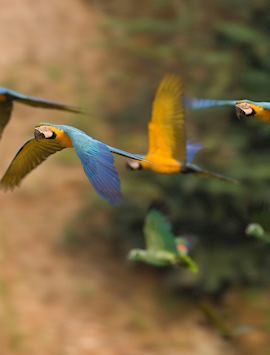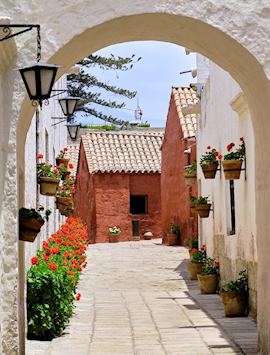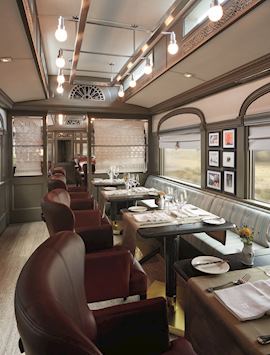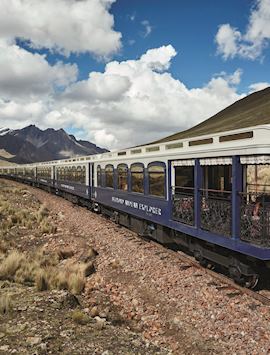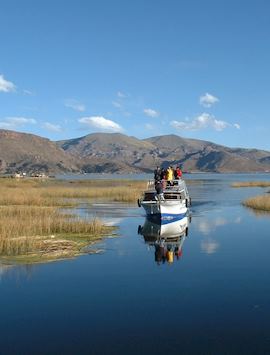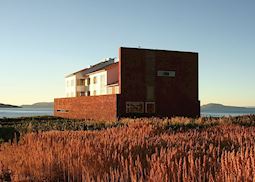Jump to:
Sea-like, sapphire blue and cupped by the Andes, Lake Titicaca is entwined with legend. For the Inca, it was where their founding god, Wiracocha, rose up before creating the city of Cuzco. The Uros people also settled here centuries ago on islands made from the lake’s reeds. There are still more than 100 islands, where you can meet some of these water-bound communities and see how they maintain their way of life.
The numbers of visitors subside as you reach the Llachon Peninsula or nearby Taquile Island. Here, you can lunch on the likes of quinoa soup and lake trout at a family home, admire the handiwork of the skilled inhabitant weavers and knitters, and walk past locals in their rainbow-bright traditional dress.
Visiting Lake Titicaca takes you to one of the highest points in Peru. At 3,812 m (12,506 ft) above sea level, it’s higher than Cuzco and Machu Picchu. The entry point to the lake is the city of Puno.
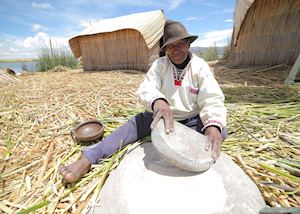 Some 30 minutes from shore, the Uros people live on islands made of totora reeds cultivated from the shallow waters of the lake. The same material goes into building the islanders’ homes and rowing boats with their distinctive high prows.
Some 30 minutes from shore, the Uros people live on islands made of totora reeds cultivated from the shallow waters of the lake. The same material goes into building the islanders’ homes and rowing boats with their distinctive high prows.
Stepping onto an island and feeling the spring of the reeds beneath your feet, and then seeing how the Uros fashion much of their existence from the natural local resource, compensates for the fact that many islands are now tourist destinations. Commercially minded islanders in bright dress will invite you into their homes to inspect and buy a range of handmade items, from embroidered cushion covers to mobiles of tiny reed boats. We take care to recommend only the most authentic islands for your tour.
An hour and a half past the Uros Islands, you can visit the Llachon Peninsula for a much quieter and genuine take on life in and around the lake through the eyes of the Aymara Indian communities there. The peninsula divides the Bay of Puno from the main body of the lake. You’ll disembark your motorboat at a shingle cove and make your way up into the village, past hayricks in fields and quinoa crops.
Accompanied by your guide, you can lunch in a family home in a dining room that looks out with an aerial perspective onto the lake. Homemade quinoa soup and lake-caught grilled trout are likely inclusions on the menu. Your hosts might also show you some of the clothes they’ve made, and invite you try them on. You have the option to stay for dinner and then overnight in a homestay, which gives you more time to walk along the headland and climb the nearby peak to look out across the lake as far as Bolivia.
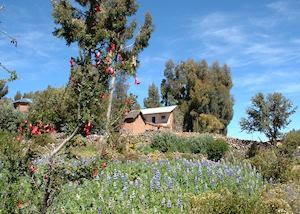 Forged in the shape of a shark tooth, Taquile Island dangles off the end of Llachon and appears like a grassy hump at first glance. In fact, it has been inhabited for more than 10,000 years and the present-day Taquilenos live here as a largely self-sufficient community. They’re eager to show you why their skills at knitting and weaving are respected throughout the Andes.
Forged in the shape of a shark tooth, Taquile Island dangles off the end of Llachon and appears like a grassy hump at first glance. In fact, it has been inhabited for more than 10,000 years and the present-day Taquilenos live here as a largely self-sufficient community. They’re eager to show you why their skills at knitting and weaving are respected throughout the Andes.
Ancient agricultural terracing still traces the contours of the island, which islanders put to use for growing potatoes, beans and quinoa. As you walk the island’s paths taking in the views of the water and the mountains, you’ll pass many of the islanders sporting handmade bright chullo hats and traditional dress.
Puno is a convenient jettison point for the lake, but it has little to offer you otherwise. We’ll suggest places to stay outside the town in more scenic surroundings.
You can reach Puno by rail on the Andean Explorer train, which runs from Cuzco to Puno and back again in a day. Alternatively, visiting the lake fits into a classic Peru itinerary as the next step after Colca Canyon (you travel between the two by road), and the local airport at Juliaca is only 40 km (25 miles) away.
Lake Titicaca also acts as a gateway to Bolivia, and it's an easy drive around the lake to the border. The Bolivian side of the lake tends to be quieter and a little quainter, if you compare the boldly painted buildings and coffee shops of Copacabana Bay with Puno.
Best time to visit Lake Titicaca
April to October is the dry season for Lake Titicaca, and Peru more generally. At this time of year, you can expect blue skies and a lower chance of rain. Its high altitude means it can still be chilly, especially at night.
who's been there
- 617-223-4920
- Make an inquiry
Suggested itineraries featuring Lake Titicaca
Our itineraries will give you suggestions for what is possible when you travel in Lake Titicaca, and they showcase routes we know work particularly well. Treat them as inspiration, because your trip will be created uniquely by one of our specialists.
Places near Lake Titicaca
- Puno 53 kilometers away
- Arequipa 225 kilometers away
- Colca Canyon 272 kilometers away
- Cuzco 357 kilometers away
- Sacred Valley 408 kilometers away
- Machu Picchu 429 kilometers away
Accommodation choices for Lake Titicaca
We've selected a range of accommodation options for when you visit Lake Titicaca. Our choices usually come recommended for their character, facilities and service or location. Our specialists always aim to suggest properties that match your preferences.
-
![Titilaka]()
Titilaka
Lake Titicaca


